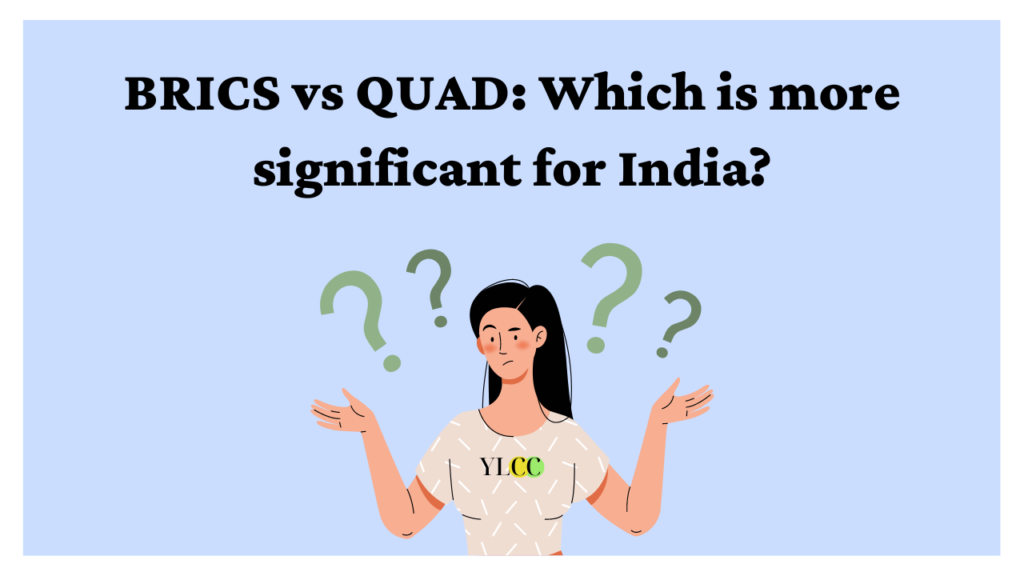
BRICS & QUAD are two of the leading regional international organisations that India is a member of. In recent times, India’s foreign policy has had an increased emphasis on national interests which has reflected in trade policies as well as diplomatic relations with Russia and the Middle-East. Needless to say, an ever-changing foreign policy will also profoundly influence India’s stance and initiative in regional organisations.
In this article, Team YLCC attempts to understand India’s interests going forward in BRICS and QUAD. Read on!
WHAT IS QUAD?
The Quadrilateral Security Dialogue (QUAD) is a group of 4 countries— India, The United States of America, Japan, and Australia. It is not a formal alliance, however, the countries have found maritime cooperation, trade, and multilateral trading to be the points of convergence between them. The countries have also recently begun to deliberate on the issue of and threat posed by China and seek to quell its stronghold on the global political and international relations.
Over the years, Quad’s diplomacy has waxed and waned. It is a loose grouping rather than a formal alliance. Japan initially emphasised the democratic identity of the four nations, whereas India seemed more comfortable emphasising functional cooperation. Australian leaders have been reluctant about creating the impression that the group is a formal alliance.[1]
The collective interest of all these countries have reaped billions of dollars’ worth of strategic partnership and trade between and amongst the countries. The United States has benefited the most from conducting trade in the Indo-Pacific region which has India, Japan, and Australia included in it. Although on the face of it, this multinational group of nations is not an institutionalised group of countries, their fervent aim over the COVID-19 pandemic was to hinder the humanitarian and regional crackdown of the Chinese Communist Party and its Premier, especially their treatment of the Uighur Muslims and the regional dominance over Hong Kong.
Having been formed in 2004, the first formal summit was only held in 2021 and there have been “Quad-plus” summits held where nations like New Zealand, South Korea, and Vietnam were invited as observers indicating a possible expansion in the future.
WHAT IS BRICS?
BRICS is an acronym for the emerging markets Brazil, Russia, India, China, and South Africa. The acronym “BRIC” was presented in a thesis by a Goldman Sachs economist Jim O’ Neil in the year 2001.[2] He had predicted that by the middle of the twenty-first century, these countries would become the superpowers. The addition of “S” and incorporation of South Africa to the acronym was made in 2010.
This bloc was not predicted to be a political union like the European Union or a militaristic one like the North Atlantic Treaty Organisation. It was purely a group of nations which were expected to be on course to not only become major players in the global politics and international relations but also one of the biggest markets in the world.
The growth rate of the Gross Domestic Product (GDP) amongst and between the countries has seen a steady growth only to be undone by the pandemic. By 2050, China and India are expected to not only remain as the world’s most populated countries but also the richest. The growing middle class consumption of the people in the countries has also been a good marker of the upward trajectory.
However, there is a looming cloud over the sustainability of BRICS. Russia and China are ideologically very similar when it comes to geo-political, societal domination, and international hegemony. This, many experts say, could suffice to make BRICS become divided into two, one led by the joint forces of Russia and China and the other by the rest.
India treads the waters of the polarising countries and their ideologies by being an active and important member of both these unions, which begs the question of which of these two would be more of an ideal, safer, more strategic and profitable alliance.
BRICS OR QUAD, WHICH IS MORE SIGNIFICANT TO INDIA?
India has always been a major believer in maintaining autonomy and not aligning ourselves with either any of the two Axes after the end of the Second World War nor the current USA-led bloc and China-led bloc. In a meeting of Foreign Affairs Ministers of the leading countries in 2022 at Slovakia, Mr. S Jaishankar emphasised on this autonomy of India that the leaders wish to utilise for the collective good of the populace.
However, political autonomy does not equate to being internationally outcast. India needs to be strategically, diplomatically, and politically powerful to handle the pressures imbibed unto them due to their membership and active participation in both BRICS and QUAD.
BRICS promotes novelty, newness, and innovation of the emerging markets with potential to achieve and scale the heights reached by the current superpowers. It also presents the citizenry of each of the countries to be able to counter the narrative led by the existing major payers. However, the Bloc faces stern challenges of despotic tendencies and draconian means of achieving supremacy- as has been repeatedly exhibited by Russia and China only for the Western world to condemn it and discourage India to condone.
QUAD offers membership in a rich pool of countries with no stern socio-political or geographical challenges. It complements the aims and goals of the country when it comes to increasing our Gross Domestic Product, and reducing our trade deficit (that is, increasing the value of exports as compared to the value of imports, over a year).
India is essentially in a position where it has to hedge its choices wisely. A seat at the QUAD table opens up several developments in the fields of trade, science, development, technology, et. al. However, a seat at the table of BRICS ensures India’s participation in the new dawn of countries and diplomatic prowess. India’s trade with Russia, even during the past ten months of the ongoing War with Ukraine, for oil and natural resources has shored up to billions of dollars. More than 50% of India’s military technology is given by Russia.[3]
CONCLUSION
Indian policymakers have battled the rhetoric and diplomacy earnestly well since the Non-Alignment Movement was spearheaded by the late Mr. Jawaharlal Nehru. India neither wished to earmark a robust foreign policy with the United States and cause tensions with Russia and China nor did it expressly wish to outmanoeuvre the United States and miss out on the unfathomable intangible benefits.
The Western world and media criticised India for not being aggressively critical of Russia’s invasion of Ukraine and still remains one of the biggest importers of its gas however, the diplomats and policymakers have wisely shifted the narrative towards joint-cooperation and sustainable development with both the Eastern and Western nations.
As an active member of competing great power coalitions, it is easy to see a new focus on multi-alignment; yet, there is no doubt that the salience of the West continues to rise in India’s great power relations. Notwithstanding Washington’s disappointment at Delhi’s reluctance to condemn Russia’s invasion of Ukraine, the US has been willing to cut political slack for India. That, in turn, is rooted in India’s centrality in the US’ Indo-Pacific strategy and the presumed Indian role in shaping the balance of power in Asia.[4]
It is, therefore, against this backdrop of a tandem between the QUAD and BRICS, that a multipolar international order presents India with an opportunity to practice multiple and multi-layered alignments based on economic, socio-political, geographical and security interests.
YLCC would like to thank its Content Team for their valuable insights in this article.
[1] Sheila A. Smith, The Quad in the Indo-Pacific: What to Know, Council on Foreign Relations, (Nov. 25th, 2022, 8:38 PM)
[2] Jim O’ Neil, Is the Emerging World Still Emerging, International Monetary Fund, (Nov. 25th, 2022, 8:50 PM)
[3] Shreya Upadhyay, BRICS, QUAD, and India’s Multialignment Strategy, Stimson, (Nov. 26th, 2022, 6:35 PM)
[4] C Raja Mohan, Between the BRICS and the QUAD: India’s New Internationalism, NUS ISAS, (Nov. 26th, 2022, 6:45 PM)






